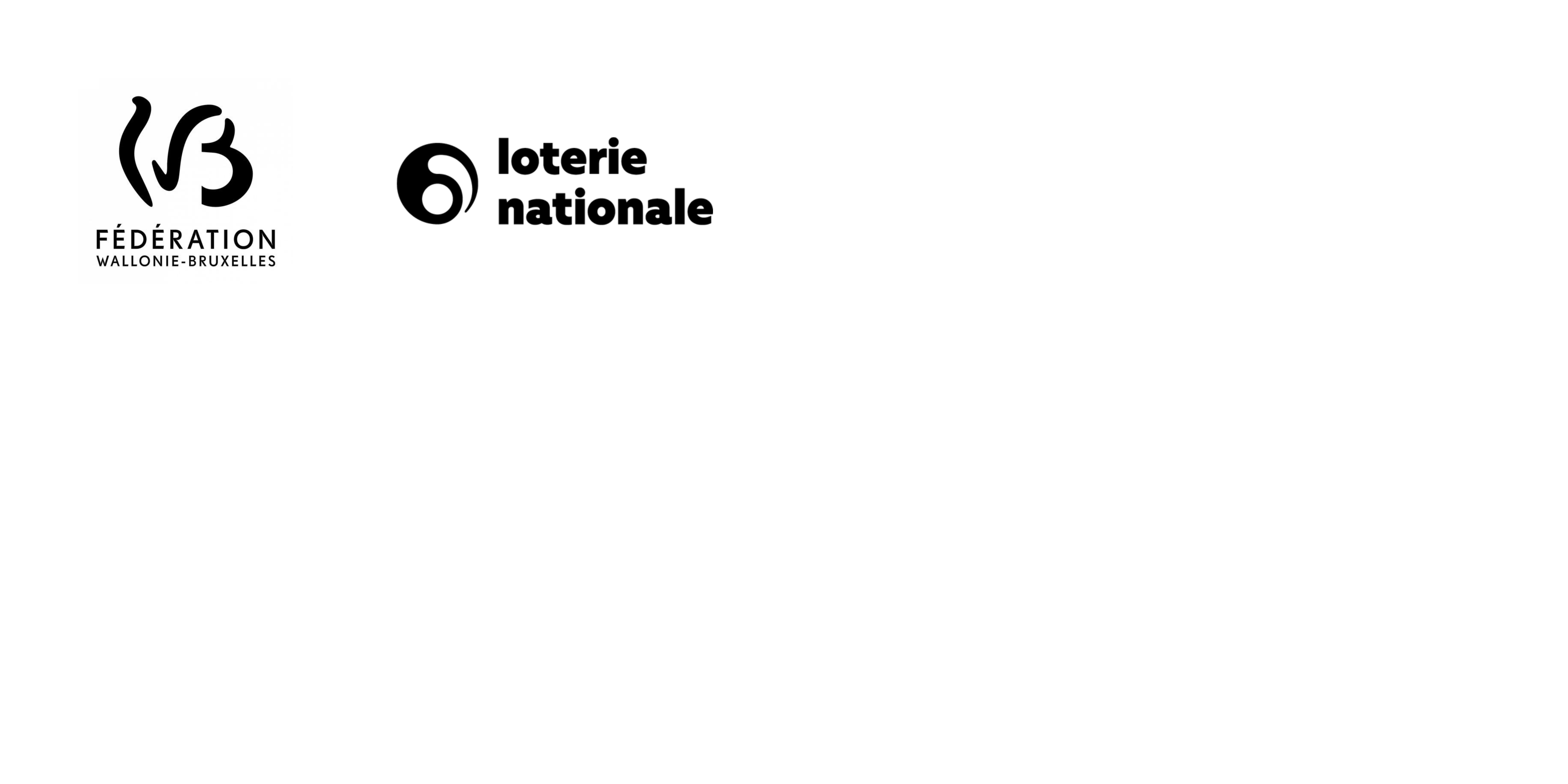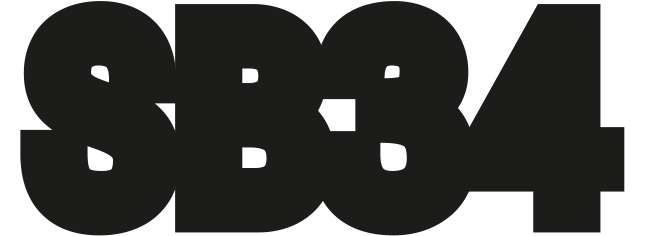
︎ SB34 Clovis
BLUE
A project by Jivan van der Ende
With Elena Op t’Eynde
19-20.10.24
︎ TEXT
‘Blue’ is the fruit of a multi-disciplinary reflection by Jivan van der Ende, who has invited graphic artist Elena Op ‘t Eynde to appropriate her work by performing as a policeman, with the aim of playing on political dynamics of power or censorship, questioning authoritarian apparatuses and gender identity in patriarchy.
Jivan van der Ende shifts her practice towards new mediums while also inviting others to take part, thereby prompting a reflection on the authorship of the artwork and its dispossession in favour of a collaborative and trust-based approach. For ‘Blue’, she seeks to play with authorship—often referred to as ‘paternity’ in a legal context—by including a new protagonist: The Policeman, portrayed by a fellow graphic artist. These two figures, embodied as one, feed off each other to manipulate the artist’s editorial work. This performed hybrid archetype then questions the boundaries of creation and its regulation, as well as the violence that can arise from the reappropriation of the object and its corrected intimacy.
︎ Conversation Between the Artist, The Policeman and the Commissaire
Joséphine Wagnier, Elena Op ‘t Eynde and Jivan van der Ende talk together in the context of the presentation of ‘Blue’ and the SB34 Clovis Open Studios. ‘Blue’ is a new installation and performance by Jivan van der Ende in preparation for her artist book, which is coming out in 2025.
19 October 2024, Brussels
Jivan, how did the fictional character ‘The Policeman’ come about in your artistic practice, which is based in print and installation work?
Jivan: ‘The Policeman’ was created in the context of my first solo exhibition ‘(ALL OF THE TIME)’, at LLS Paleis, Antwerp 2020. For this show I created a performance and installation which looped every 30 minutes. It consisted of print work, video work, an exhibition publication and scenes which glued the spectacle together. In the performance/exhibition I wanted to work live in the space with notions such as power relations and so I came up with the idea of a character who had authority over my work and the space. This character would take control of the exhibition through patrolling, turning works on/off, enforcing obedience. With her scenes she manipulated the works and made the audience witness the manipulation. Following a set of instructions The Policeman's scenes linked the various works together. The ultimate power in determining how the works were displayed lay with The Policeman. As an artist, I am interested in relinquishing control over my work, questioning what it means to be a maker and experimenting with the process of making. Through genderbending and playful experimentation, I developed the absurdist, authoritarian-critical, patriarchal role of The Policeman for Elena Op ‘t Eynde, friend, graphic designer and publisher.
Why was it necessary for The Policeman to make a comeback?
Jivan: It was so much fun to orchestrate a return of the character of The Policeman, and create an elaborate opportunity for myself to work on power dynamics again, more specifically the ones we are submitted to and oppressed by as queer women. It was quite cathartic to set up a simulation of a violent patriarchal structure within the context of my own practice, and to work in it with a trusted friend, to artistically analyse these structures together and the societal institutions that keep violent authority, sexism and queerphobia alive. Another reason to bring the character back was to challenge the idea of authorship and what an art work actually is. I have been working on a series of print works since 2020 and wanted to develop and challenge the idea of publishing this series, through experimenting with the notion of editing and publishing. With the idea of making a book with Elena, the stars were aligned to develop a publication (and therefore a performative extension) of the series with her designing and editing the publication as The Policeman. The way we collaborated also invited a kind of intimacy which interested me a lot, both into the process and into the way the work is presented to the audience. We are publishing the final series and showing how we got there. We have created this character from personal perspectives and experiences with violence, sexism and authority and it has resulted in a laborious, fun and gender bending exploration of character development.
Elena, what is your perspective on collaborating with artists and the medium of the artist book?
Elena: As a graphic designer I’ve always been drawn to working with artists. I find it interesting to immerse myself in another’s practice, examine their mediums and philosophies and try to translate this to print. It’s a really fun challenge for a graphic designer to bridge that gap between design and fine art through the artist's publication. I like to take my time getting to know the artist’s practice which is why I really enjoy long-term collaborations. To get to see them and their work evolve is exciting and brings along new possibilities for expressing things on paper. The artist’s book is a great companion to an artist's practice. It allows the artist to capture a moment in their practice and fix it in a compendium. One that can be easily shared, that an audience can take home and one that can later be archived to reflect on. Even more so for performance artists. I’m fascinated by this fleeting aspect of movement and trying to translate that not only onto the paper but also into the paper. Reading can be such a tactile and physical experience. In the past few years I’ve worked more and more with performance artists, trying to design artist’s books that not only reflect the performance but also become a part of it. It feels quite fitting that now I too become part of the performance in some way and through this find new ways to design a publication.
In this project you are not designing as yourself, but designing while playing the role of The Policeman. Did this bring anything new to your designing practice?
Elena: It’s been quite a challenge to take on this role and come up with ways to design a publication, as I feel I really leave myself behind when I step into the shoes of The Policeman, which also means I leave the graphic designer that is me behind. I only really started to see how things were coming together once we started rehearsing and I got back in the suit, back into his skin. During the first performance in LLS, back in 2020, he was a coat I slipped on, there wasn’t much nuance to him yet for me. Over the course of the preparation for the design of this publication and this performance it was nice to be able to talk about him more, to understand what he means to the artist, and give him more context. I’ve come to understand that a lot of the tools that The Policeman uses—control, authority, ownership, censorship—are also tools that are in some way integrated into a designer's practice. I’m very aware when an artist entrusts me with their images and words that I essentially take control over how these things will be represented and interpreted. Usually I approach this very carefully, it’s one of the reasons the conversation with the artist is an important element in my design process. In taking on the character of The Policeman I get to let my mindfulness around this go and take full ownership of the material of the artist, which has been surprisingly difficult. The side of me that looks for the carefully analysed aesthetic choice still plagues me in the back of my mind while The Policeman tries to go to town on Jivan’s material.
How is the collaboration between the artist and graphic designer influenced by the use of a fictional authority figure?
Elena: The fictional character has taken on a very dominant presence in our collaboration, as was to be expected of him. It’s been an interesting experience to take the focus of the artist and the designer and talk about this fictional man who now stands between us. We’ve spent a lot of time getting to know him, and as he’s taken a more clear shape he’s also been more dominantly present. During our rehearsals I would slip in and out of character and we would dissect The Policeman’s actions which would give me, the graphic designer, a better understanding of his raison d'être, and therefore also a better idea of the tools he uses that can be translated into the design process. Jivan would comment on his oppressive behavior and the way he represents things she struggles with. But as this knowledge was passed to on me, it was automatically passed on to The Policeman, who could in turn use all this information against her work in his next appearance. In this way, the role of The Policeman got fleshed out further, and the framework we were building around his actions became clearer. It’s a very hands-on way of creating a design process that has allowed me to let go of my initial ideas around the publication design, which were initially playing with quite stereotypical images of censorship and oppression. By taking on this role the actual action of designing has become an organic process that is almost out of my hands. It’s going to be interesting to see what material comes out of this and how it will eventually turn into an actual publication.
Joséphine, would you like to expand on your practice as a cultural producer and exhibition maker? Can you tell us a bit about your perspective on the practice of curating?
Joséphine: I’ll start by saying that the connotation of the term commissaire*, the French word for curator (*used to designate also a chief policeman), is quite revealing of what is expected of us. It is our responsibility to oversee, to ensure the smooth running and proper management of a project or exhibition. I have long sought to emancipate myself from this term, as well as from that of curator which literally means to take care of. And in French, again, it's reminiscent of the word curatelle, which refers to the act of taking charge of a legal adult’s administrative or financial affairs. It feels almost maternal, it’s just a switch from a patriarchal figure that has been disguised. The notion of care has emerged with a certain degree of goodwill in contemporary art, but in my view, it’s not explored deeply enough. To say we are implementing care without truly questioning it or practicing it brings forth numerous forms of violence. And it’s also very difficult to consider oneself as the sole caretaker: caretaker of the works, the artists, the project. There’s something very self-proclaimed and individualising about it. Certainly, a person needs to be designated to coordinate tasks that are secondary to the creation, but we shouldn’t take on the sole role of responsibility. We need to demystify this inaccessible figure as well—a curator is nothing without all the other individuals who accompany a project.
In my case and in this context, it's rather equivocal: I'm not the curator who commissioned or thought up this project, but the one who accompanies it attentively and without imposing anything. Quite the opposite of the third entity that makes up the ‘Blue’ project, the Policeman. This demonstrates the desire to keep a distance from the figure of the commissaire/curator, who can provide or demand a certain service. If I'd signed the project as a curator, perhaps that would have generated other parameters, other expectations. And I wonder: would the Policeman have been able to appear between the artists involved in the project and this other figure with this ability to persuade one choice rather than another? Would he have stood up to the commissaire?
How do you relate to the egomaniac stereotypical figure of the curator?
Joséphine: On the one hand, I understand why this very self-centred figure emerged. As mentioned earlier, it’s a laborious job and not very recognised, and we are constantly pushed to prove ourselves. The discipline has also come to privilege individuals as the star curators, rather than committees or collectives. There has been a lot of abuse and egos. Many have taken advantage of this situation. Fortunately, we’ve had other models or other ways to make exhibitions, with artists inviting other artists, opening up the creative process to other paths, other perspectives. Just as Jivan did with Elena. On the other hand, there's a whole imaginary world that stems from the language we use, as mentioned above: what is implied by the term commissaire or curator. For people outside the art world, or with little knowledge of the vocation, the term can evoke in them a certain idea of responsibility and must-respect, coming from a decision-maker who embodies law and order. I don't know if this construct can really go to our heads, I haven't yet seen any uniformed curators either, even if we do tend to observe fairly standardised postures, photographed portraits and ways of looking. One thing is certain: there are several figures in one, because it has to respond to several demands. It often has to deal with the institution that hires them, and that's where other disguises come into play: the diplomat, the supervisor, the logistics manager, the delegate, etc.
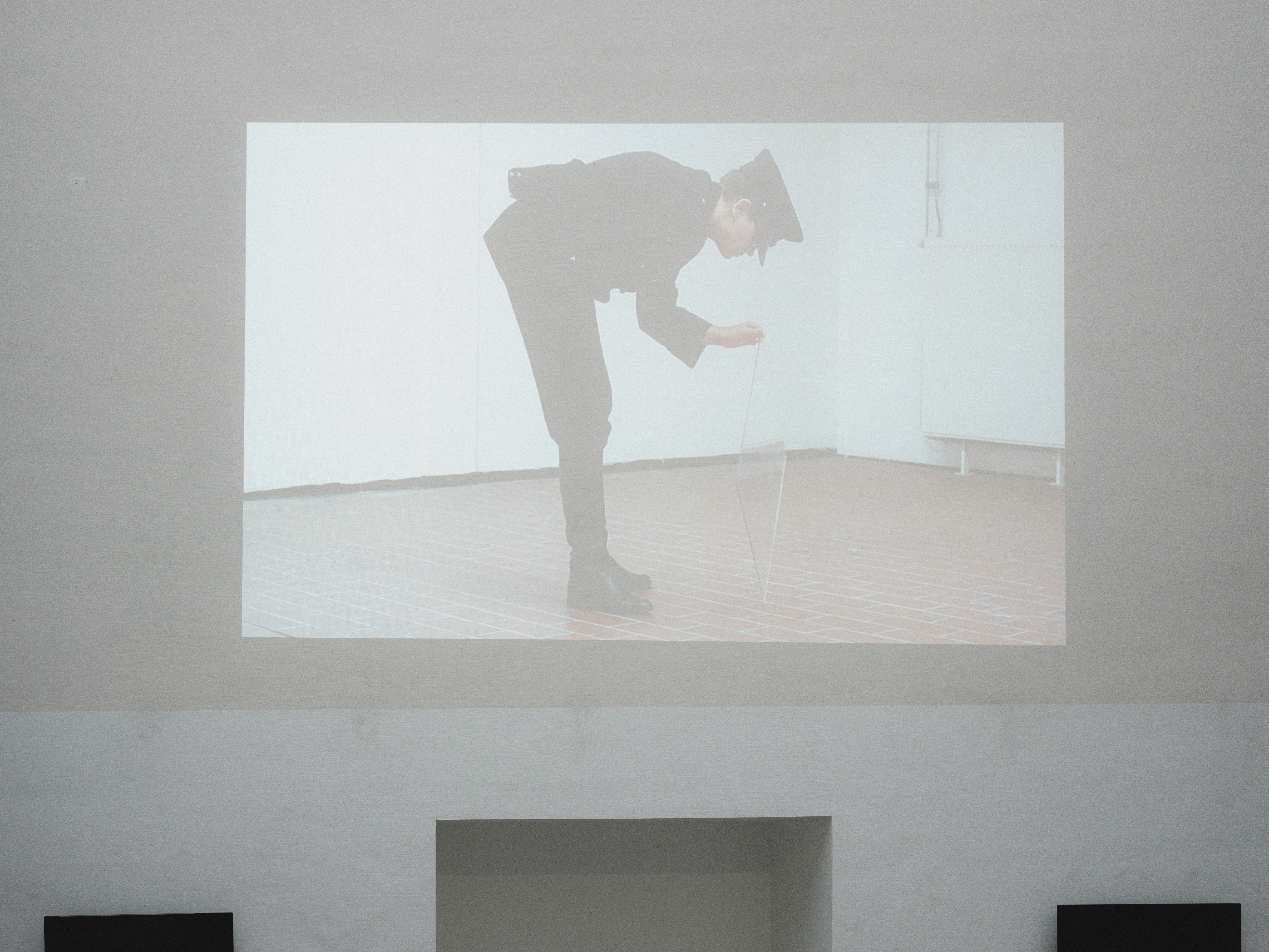
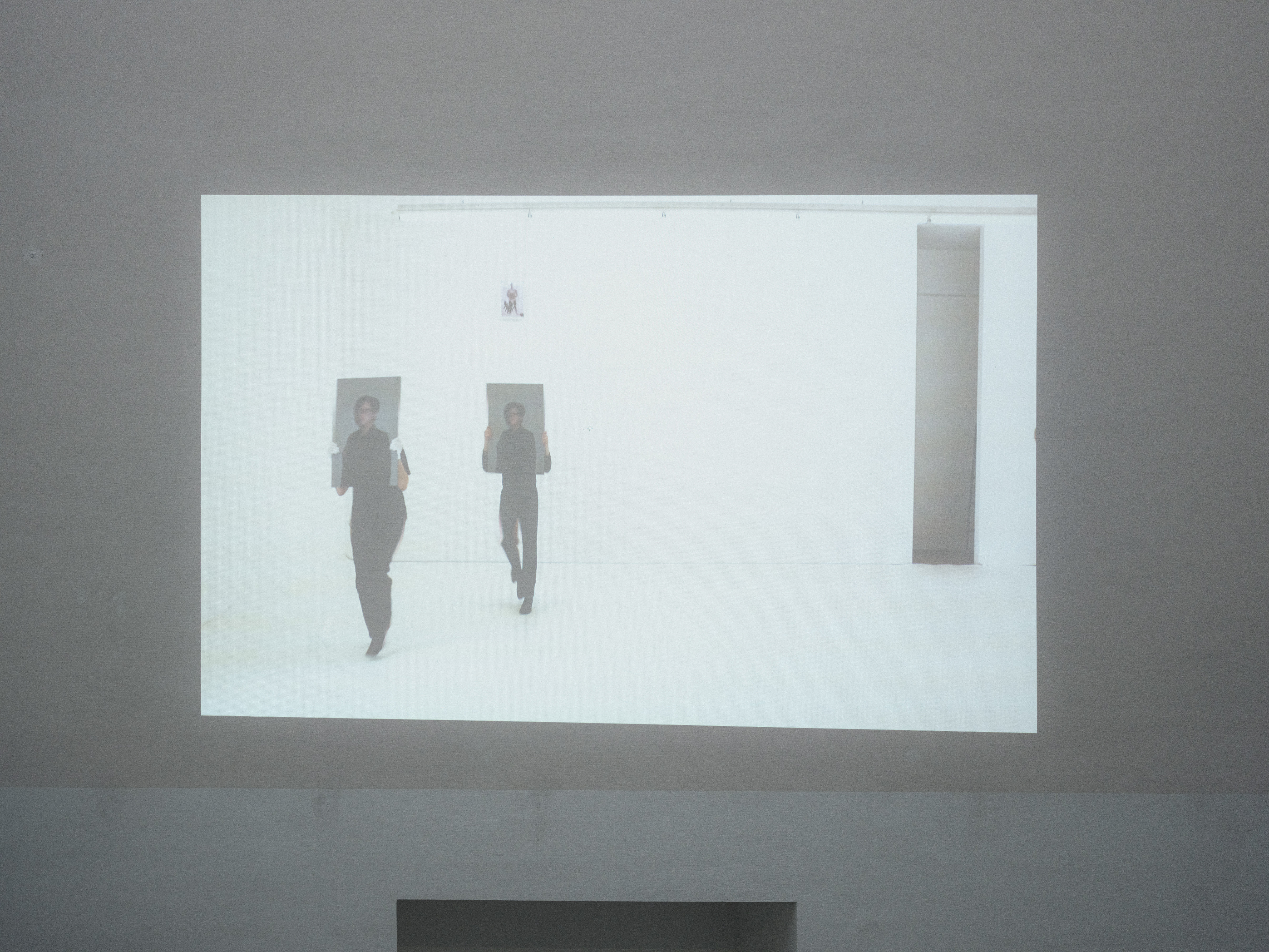


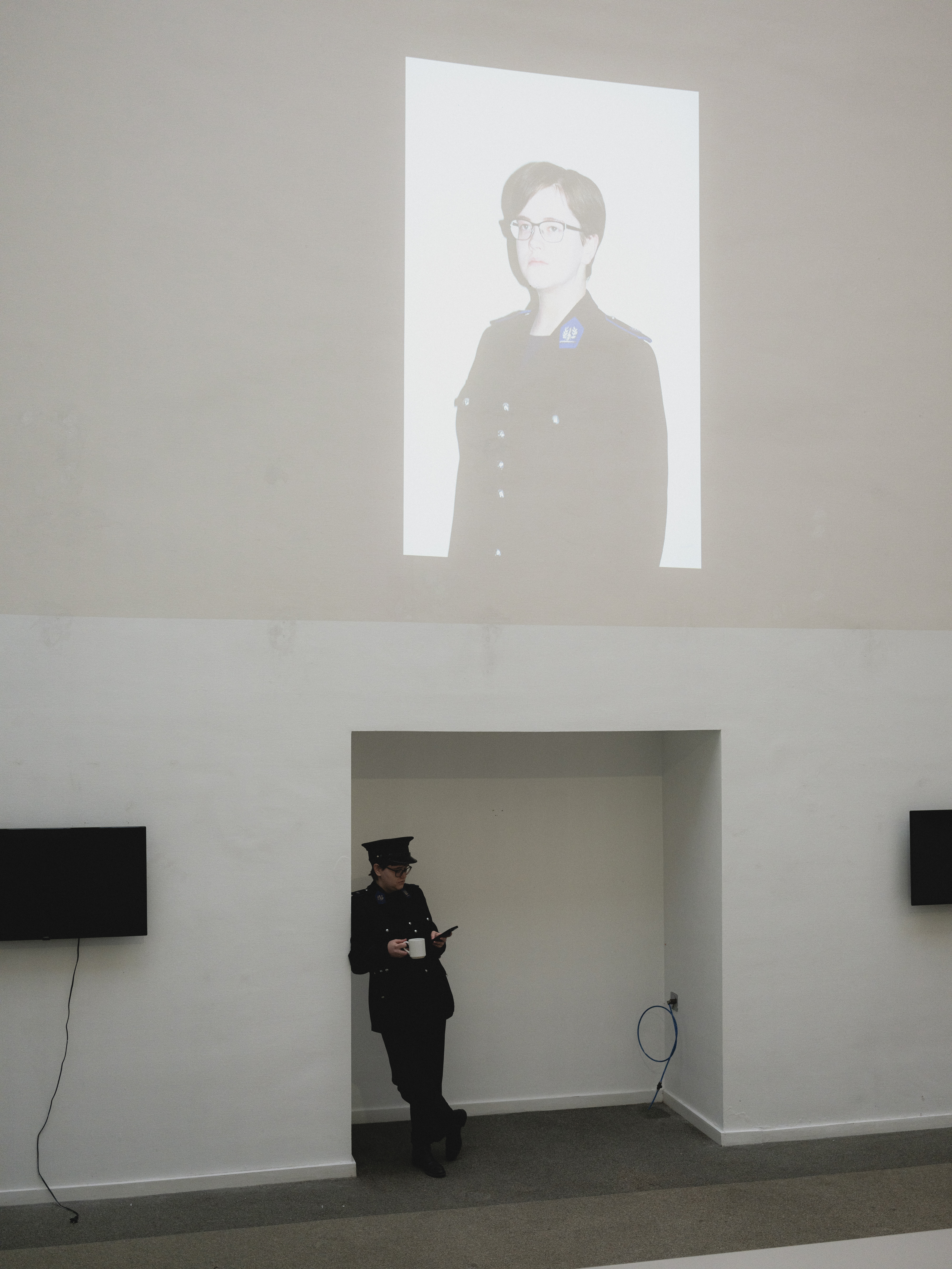

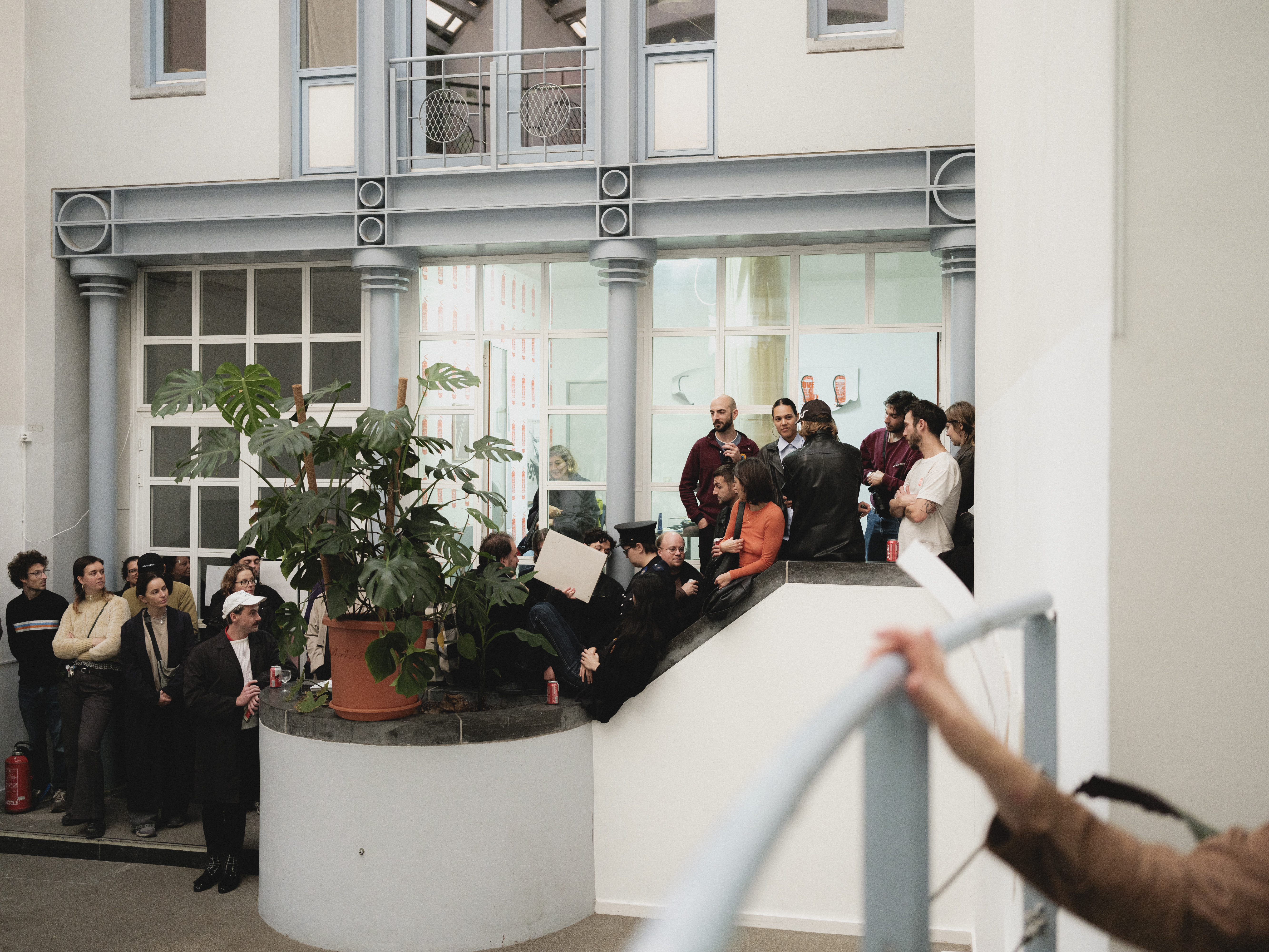

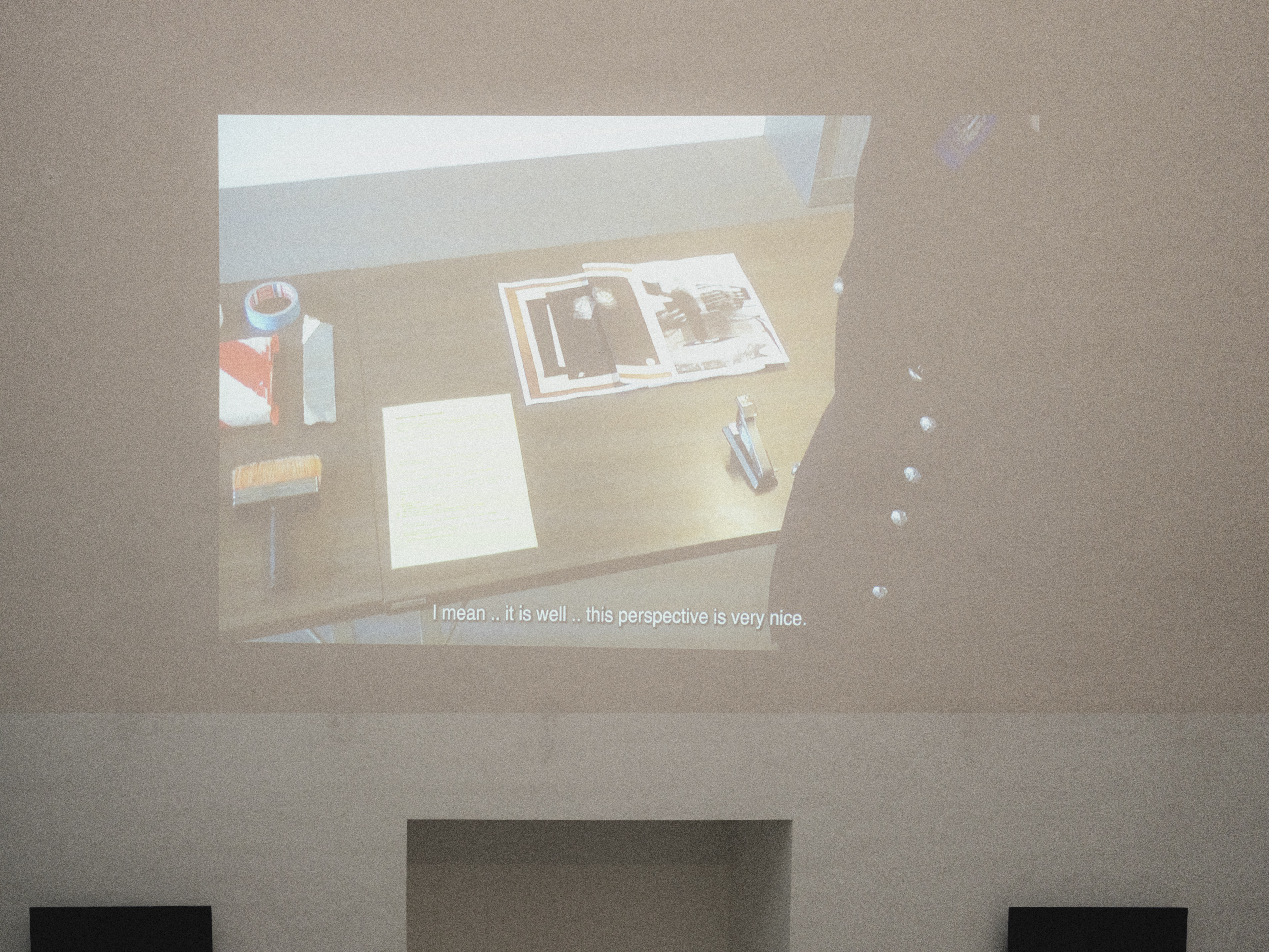
︎ TEXTE
“Blue” est le fruit d’une réflexion multidisciplinaire menée par Jivan van der Ende, qui initie ici une nouvelle collaboration avec la graphiste Elena Op ‘t Eynde l'invitant à s'approprier son œuvre en performant un policier, dans le but de jouer des dynamiques politiques de pouvoir, de censure, ou encore de questionner l’apparat autoritaire et son identité de genre inscrite dans un modèle patriarcal.
Jivan van der Ende déplace sa pratique vers de nouveaux supports mais aussi en conviant d’autres à y prendre part, amenant alors une réflexion sur la parentalité et une dépossession de l'œuvre vers un faire collaboratif et en confiance. Pour “Blue”, elle souhaite jouer avec l’authorship - que l’on désigne bien souvent “paternité” dans un cadre juridique, en y incluant un nouveau protagoniste : le Policier interprété par une comparse graphiste. Ces deux figures incarnées en une s’alimentent mutuellement pour manipuler le travail éditorial de l’artiste, l'archétype hybride performée vient alors questionner les limites de la création et de sa réglementation, mais aussi de la violence qui peut en découler sur la réappropriation de l’objet et de son intimité rectifié.
︎ Conversation entre l’Artiste, le Policier et la Commissaire
Joséphine Wagnier, Elena Op ‘t Eynde et Jivan van der Ende entrent en dialogue dans le cadre de la présentation de “Blue” et des Open Studios à SB34 Clovis. “Blue” est une nouvelle installation et performance de Jivan van der Ende préparant son livre d’artiste, dont la sortie est prévue pour 2025.
19 octobre 2024, Bruxelles
Jivan, comment le personnage fictif du “Policier” est-il apparu dans ta pratique artistique, qui repose principalement sur le travail d’impression et d’installation ?
Jivan : Le personnage fictif du “Policier” a été créé dans le cadre de ma première exposition personnelle “(ALL OF THE TIME)”, à LLS Paleis à Anvers en 2020. Pour cette exposition, j’ai pensé une performance et une installation que nous répétions en boucle toutes les 30 minutes. Elle se composait d’œuvres imprimées, de vidéos, d’une publication et de scènes qui liaient l’ensemble du spectacle. Dans la performance/exposition, je souhaitais travailler dans l’espace, et cela en direct, avec des notions telles que les relations de pouvoir et j’ai donc eu l’idée d’un personnage qui avait une certaine autorité sur mon travail et sur cet espace. Ce personnage contrôlait l’exposition en patrouillant, allumant ou éteignant des œuvres, imposant l’obéissance. Avec ses gestes elle manipulait les œuvres et faisait en sorte que le public soit témoin de cette manipulation. En suivant un ensemble d’instructions, les activations du Policier reliaient les différentes œuvres entre elles. Le pouvoir ultime sur la façon dont les œuvres étaient exposées revenait finalement au Policier. En tant qu’artiste, je m’intéresse au fait de renoncer au contrôle sur mon travail, de questionner ce que signifie être créateur·ice et d’expérimenter le processus de création. Par le biais du travestissement et de l’expérimentation ludique, j’ai développé le rôle absurde, critique de l’autorité patriarcale, du Policier pour Elena Op ‘t Eynde, amie, graphiste et éditrice.
Pourquoi était-il nécessaire que le Policier revienne et fasse son retour ?
Jivan : Ce fut un grand plaisir d’orchestrer le retour du personnage du Policier et de saisir une opportunité pour moi de retravailler les dynamiques de pouvoir, notamment celles auxquelles nous sommes soumises et oppressées en tant que femmes queer. Ce fut presque cathartique de mettre en place une simulation d’une structure patriarcale violente dans le cadre de ma propre pratique, et de travailler avec une amie de confiance, pour analyser artistiquement ces structures et les institutions qui perpétuent l’autorité violente, le sexisme et la queerphobie.
Une autre raison pour laquelle j’ai fait revenir ce personnage était de remettre en question l’idée de la paternité artistique et de ce qu’est réellement une œuvre d’art. Depuis 2020, je travaille sur une série d’œuvres imprimées et je souhaitais publier cette série en expérimentant, en jouant avec les notions d’édition et de publication. Le projet de créer un livre avec Elena s’alignait parfaitement sur ce projet, et nous avons ainsi développé une publication (et de plus une extension performative) avec elle en tant qu’éditrice et conceptrice de la publication sous les traits du Policier. La façon dont nous avons collaboré a également favorisé une forme d’intimité qui m’a beaucoup intéressée, tant dans le processus que dans la présentation de l’œuvre au public. Nous publions la série finale tout en montrant comment nous y sommes parvenues. Ce personnage est né de perspectives personnelles et d’expériences liées à la violence, au sexisme et à l’autorité, et il a donné lieu à une recherche laborieuse, amusante et transgressive sur le développement du personnage.
Elena, quelle est ta perspective sur la collaboration avec des artistes et le médium du livre d’artiste ?
Elena : En tant que graphiste, j’ai toujours été attirée par la collaboration avec les artistes. Je trouve intéressant de m’immerger dans la pratique d’un·e autre, d’examiner ses médiums et positions et d’essayer de les traduire en impression. Cela représente un défi stimulant pour un·e graphiste de combler cet écart entre le design et les beaux-arts à travers la publication d’artiste. J’aime prendre le temps de me familiariser avec la pratique de l’artiste, et c’est pourquoi j’apprécie particulièrement les collaborations sur le long terme. Voir l’artiste et son travail évoluer est excitant et apporte de nouvelles possibilités d’expression sur papier. Le livre d’artiste est un·e excellent·e camarade pour la pratique d’un·e artiste. Il lui permet de capturer un moment précis dans sa pratique et de le fixer en un compendium. Un objet facilement partageable, que le public peut emporter chez lui et qui peut être archivé pour réflexion ultérieure. Encore plus pour les artistes performeur·euses. Je suis fascinée par cet aspect éphémère du mouvement et par la tentative de le traduire non seulement sur le papier, mais aussi à travers le papier. La lecture peut être une expérience tactile et physique. Ces dernières années, j’ai de plus en plus travaillé avec des artistes performeur·euses, en essayant de concevoir des livres d’artistes qui non seulement reflètent la performance, mais en deviennent une partie intégrante. Il me semble tout à fait approprié que, dans ce projet, je devienne moi aussi une partie de la performance et que cela me permette de découvrir de nouvelles façons de concevoir une publication.
Dans ce projet tu n’incarnes pas ta personne, mais incarnes plutôt le rôle du Policier. Cela a-t-il apporté quelque chose de nouveau à votre pratique du design ?
Elena : Endosser ce rôle a été tout un défi, notamment pour trouver des façons de concevoir une publication, car j’ai vraiment l’impression de devoir me détacher de moi-même lorsque je me glisse dans la peau du Policier, ce qui signifie aussi que je laisse derrière moi la graphiste que je suis. J’ai commencé à réaliser comment les choses prenaient vraiment forme que lorsque nous avons commencé les répétitions, et que j’ai remis le costume, que je suis rentrée de nouveau dans sa peau. Lors de la première performance à LLS, en 2020, il était question simplement d'un manteau que j’enfilais ; il n’y avait pas encore beaucoup de nuances pour moi. Au cours de la conception de cette publication et de cette performance, c’était intéressant de pouvoir parler davantage de lui, de comprendre ce qu’il représente pour l’artiste et de lui donner plus de contexte. J’ai compris que de nombreux outils qu’utilise le Policier — le contrôle, l’autorité, la propriété, la censure — sont également des outils que l’on intègre d’une certaine manière dans la pratique du design. Je suis très consciente qu’un·e artiste me confie ses images et son vocabulaire, et que je prends essentiellement le contrôle sur la façon dont les éléments seront représentés et interprétés. Habituellement, j’aborde cela avec beaucoup de précaution, c’est une des raisons pour lesquelles la conversation avec l’artiste est un élément important dans mon processus de travail. En incarnant le personnage du Policier, je me dois de laisser de côté cette attention et prendre pleinement possession du matériel de l’artiste, ce qui a été étonnamment difficile. La part de moi qui cherche des possibilités esthétiques soigneusement analysées me tourmente encore, alors que le Policier lui s’approprie pleinement le contenu de Jivan.
Comment la collaboration entre l'artiste et la graphiste est-elle influencée par l'utilisation d'un personnage d'autorité fictif ?
Elena : Le personnage fictif a pris une place dominante importante dans notre collaboration, et c’est ce qu’on attendait de lui. Ça a été une expérience intéressante de détourner l'attention en tant qu’artiste et graphiste pour parler de cet homme fictif qui se dresse maintenant entre nous. Nous avons passé beaucoup de temps à faire sa connaissance, et à mesure qu'il prenait forme, il devenait également plus présent et imposant. Pendant nos répétitions, je glissais dans et hors du personnage, et nous disséquions les actions du Policier, ce qui me donnait une meilleure compréhension de sa raison d'être, et donc une idée plus précise des outils qu'il utilise et que je pourrais traduire dans le processus de conception en tant que graphiste. Jivan commentait son comportement oppressif et formulait la façon dont il représente des réalités contre lesquelles elle lutte. Mais à mesure que cette connaissance me parvenait, elle était automatiquement transmise au Policier, qui pouvait à son tour utiliser toutes ces informations contre son travail lors de sa prochaine apparition. De cette façon, le rôle du Policier s'est encore plus étoffé, et le cadre que nous construisions autour de ses actions est devenu plus clair. C'est une méthode très pratique de créer un processus de conception qui m'a permis de lâcher prise sur mes idées initiales concernant la conception de la publication, qui jouaient avec des images assez stéréotypées de la censure et de l'oppression. En prenant ce rôle, l'acte même de concevoir est devenu un processus organique et presque hors de mon contrôle. Ce sera intéressant de voir quelle ressource en ressortira et comment cela se transformera finalement en une véritable publication.
Joséphine, aimerais-tu approfondir ta pratique en tant que productrice culturelle et faiseuse d'exposition ? Peux-tu nous parler de votre perspective sur la pratique du commissariat ?
Joséphine : Je commencerai par rappeler la connotation du terme “commissaire” d’exposition, mot généralement utilisé pour désigner un·e curateur·ice dans la francophonie, qui est assez révélatrice de ce qu'on attend de nous. Il est de notre responsabilité de superviser, de garantir le bon déroulement et la bonne gestion d'un projet ou d'une exposition. J'ai longtemps cherché à m'émanciper de ce terme, ainsi que de celui de “curateur·ice”, qui découle littéralement de la notion de prendre soin. Et en français, encore une fois, cela rappelle le mot “curatelle”, qui fait référence à l'acte de prendre en charge un adulte. Cela semble presque maternel, c'est justement une figure patriarcale qui a été déguisée. La notion de soin a émergé avec une certaine bonne volonté dans l'art contemporain, mais je pense qu’elle n'est pas suffisamment étudiée en profondeur. Dire que nous mettons en œuvre le soin sans vraiment le questionner ou parfois vraiment le pratiquer entraîne de nombreuses formes de violence. Et il est également très difficile de se considérer comme étant la seule personne qui prend soin du tout ; des œuvres, des artistes, du projet. Il y a quelque chose de très autoproclamé et d'individualisant. Certes, une personne doit être désignée pour coordonner des tâches qui sont périphériques à la création, mais nous ne devrions pas endosser seul·e le rôle de responsable. Il faut aussi démystifier cette figure inaccessible — un·e commissaire d’exposition n'est rien sans toutes les autres personnes qui accompagnent le projet.
Dans mon cas et dans ce contexte, c'est assez équivoque : je ne suis pas la commissaire ayant commandité ou pensé ce projet, mais celle qui accompagne le projet avec attention et sans s’imposer. Tout le contraire de cette troisième entité qui compose le projet “Blue”, c'est-à-dire le Policier. Cela démontre la volonté de rester à distance de cette figure du commissaire d’exposition qui peut amener ou demander une certaine prestation. Si j’avais signé le projet en tant que commissaire d’exposition, peut-être que cela aurait engendré d’autres paramètres, d’autres attentes. Et je me demande : est-ce que le Policier aurait pu se manifester entre les artistes impliquées dans le projet et cette autre figure ayant cette aptitude à pouvoir à persuader d’un choix plutôt qu’un autre ? Est-ce qu’il aurait fait face à la commissaire ?
Comment te situes-tu par rapport à la figure stéréotypée du commissaire égocentrique ?
Joséphine : D'une part, je comprends pourquoi cette figure très centrée sur elle-même a émergé. C'est un travail laborieux et peu reconnu, et nous sommes constamment poussés à faire nos preuves. La discipline en est également venue à privilégier des personnalités à devenir des commissaires vedettes individuelles, plutôt que visibiliser des comités ou collectifs. Il y a eu beaucoup d'abus et d'égos. Un bon nombre en ont profité. Heureusement, nous avons eu et avons d'autres modèles ou d'autres façons de concevoir la pratique de l’exposition, avec notamment des artistes invitant d’autres, en ouvrant également la création à d’autres voies, d’autres perspectives. Tout comme Jivan l’a fait avec Elena. D’autre part, il y a tout un imaginaire qui découle du langage que l’on emploie comme mentionné précédemment : ce que sous-entend le terme commissaire, ou même curateur·ice. Pour des personnes en dehors du milieu de l’art et de la culture ou ayant peu de connaissance sur la vocation de commissaire d’exposition, l'appellation peut susciter chez elleux une certaine idée de responsabilité, de respect, venant d’un agent décisionnaire incarnant la loi et l’ordre. Je ne sais pas si cette construction peut vraiment nous monter à la tête, je n’ai pas encore vu de comparses en uniformes non plus, même si on a tendance à observer des postures, des portraits photographiés, des manières de paraître assez standardisés. Une chose est sûre c’est qu’il existe plusieurs figures en une, car elle doit répondre à plusieurs demandes. Souvent elle doit faire avec l’institution qui l’embauche, et c’est là que d’autres déguisements peuvent voir le jour : celui de le·la diplomate, de le·la superviseur·euse, du·de la chargé·e de logistique, du·de la délégué·e…

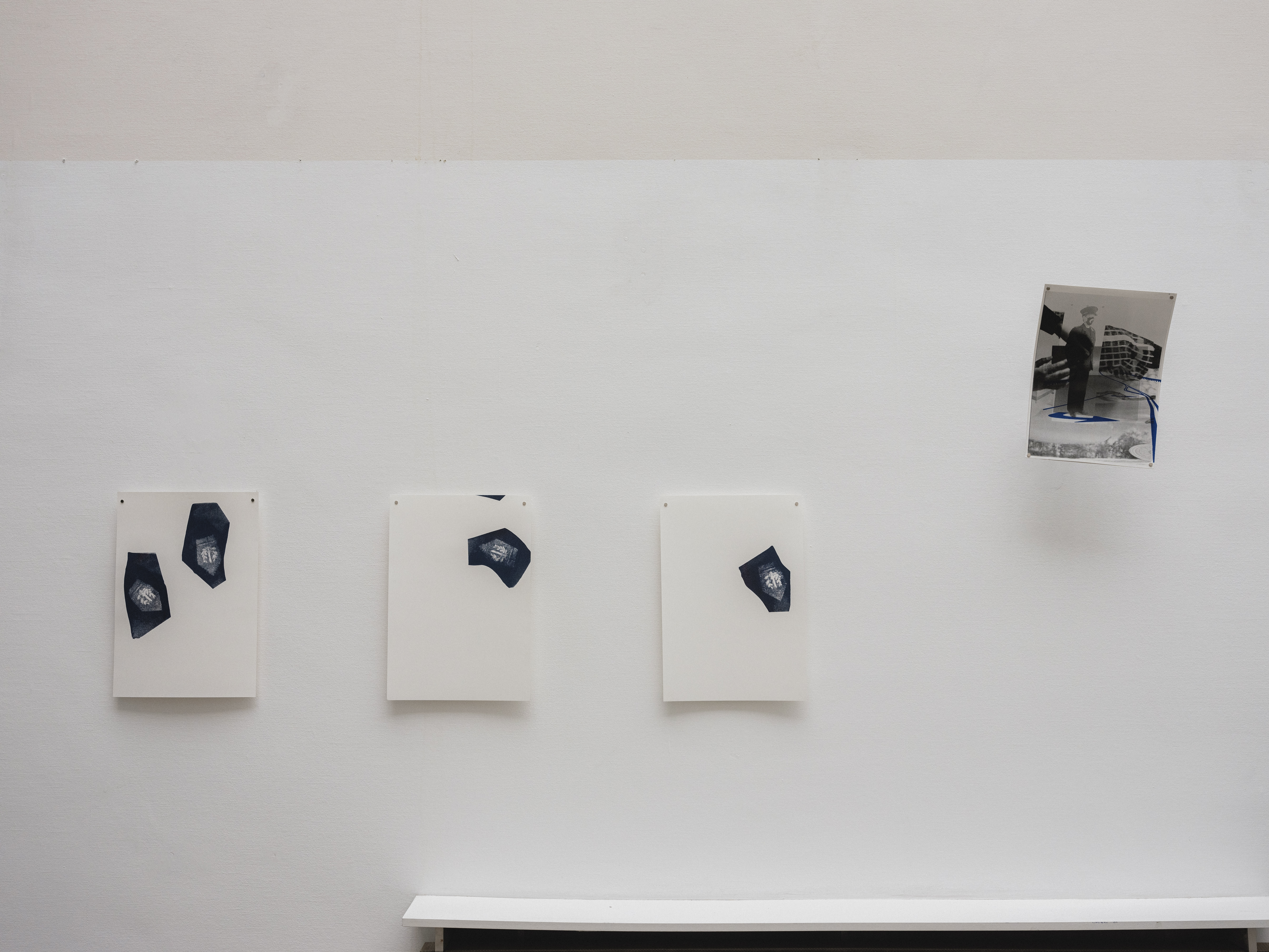



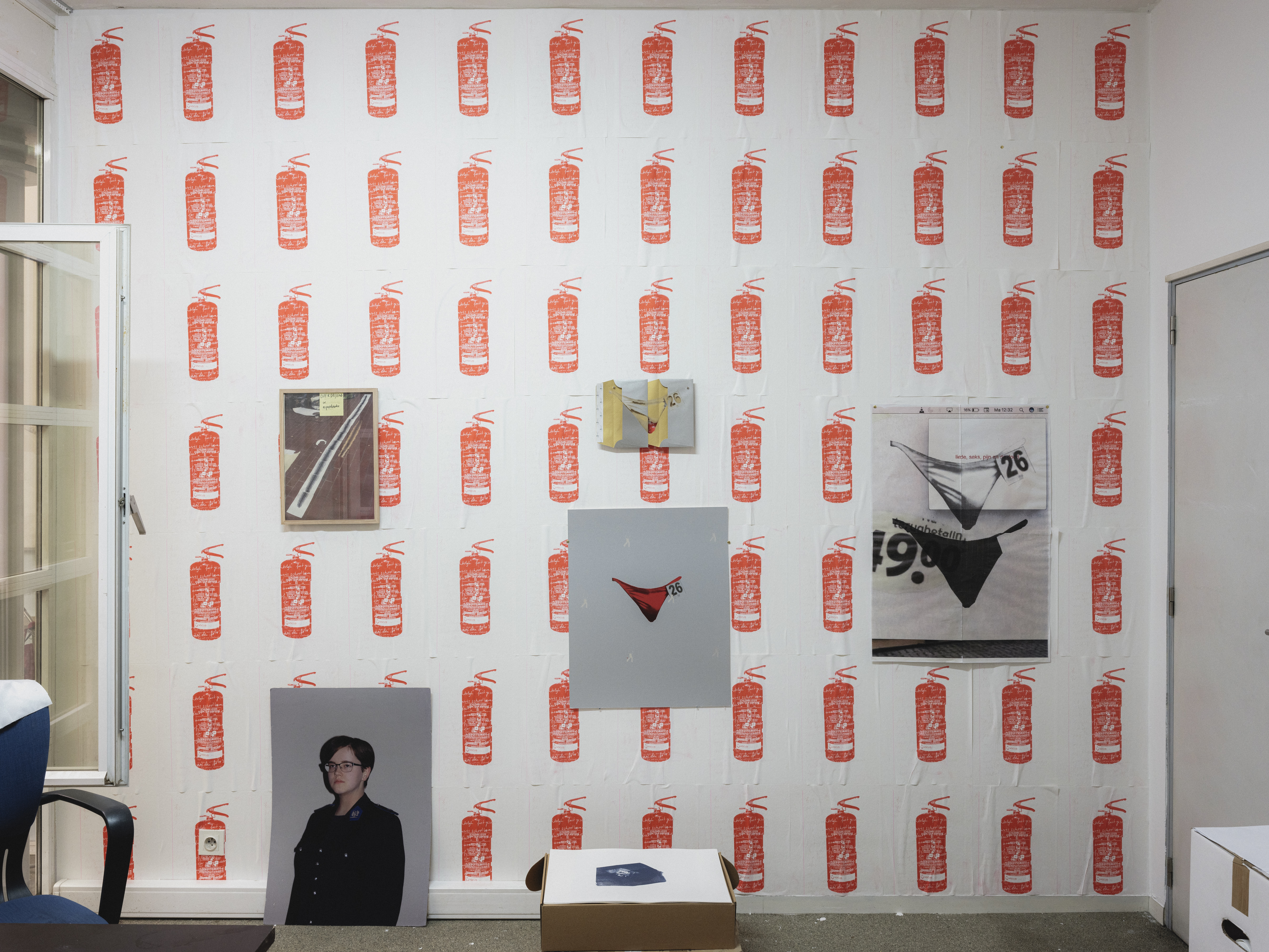
(c) Adam Paluch
Supported by Loterie Nationale and Fédération Wallonie-Bruxelles, with additional support from VGC Brussels and de Nederlandse Ambassade in België for Jivan van der Ende’s project.

